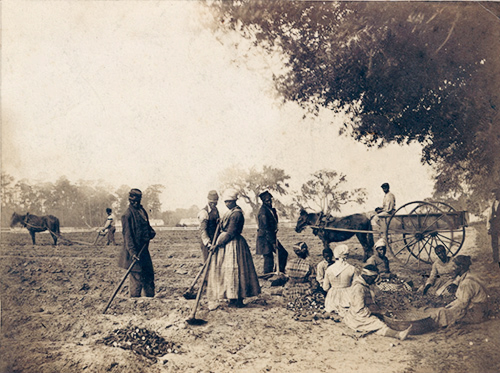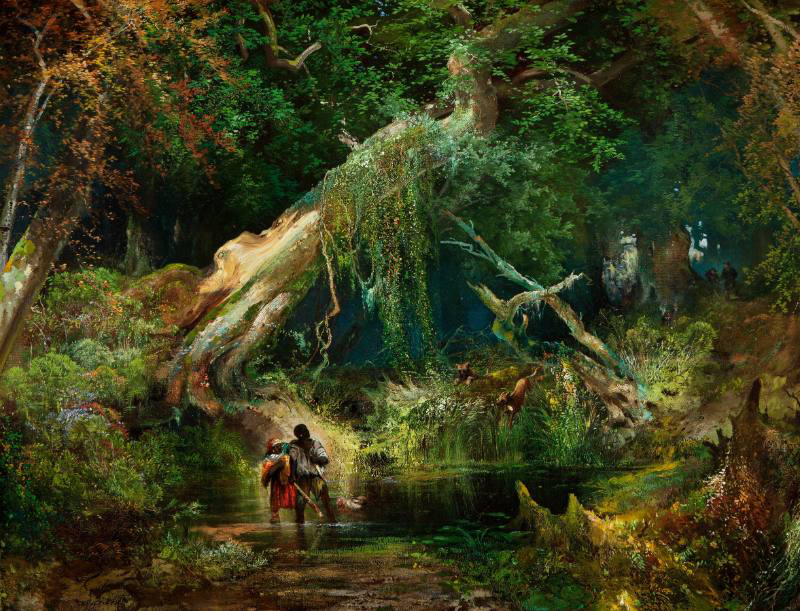Slavery and the Environment
by David Silkenat
 A fugitive from bondage in Mississippi, William Anderson observed in 1857 that “it is almost impossible for slaves to escape” because “there are a great many things to encounter in escaping, vis: large and small rivers, lakes, panthers, bears, snakes, alligators, white and black men, blood hounds, guns, and, above all, the dangers of starvation.”[1] In enumerating the many barriers to freedom, Anderson understood that slavery’s shackles were not just man-made: enslaved people toiled in an environment that conspired with slave owners to keep African Americans in bondage. The environmental conditions contributed to the brutality of slavery. At the same time, Anderson and other enslaved people knew the Southern environment in a way their enslavers never could. By day, they plucked worms from tobacco leaves, trod barefoot in the mud as they hoed rice fields, and felt the late summer sun on their backs as they picked cotton. By night, they clandestinely took to the woods and swamps to trap opossums and turtles, to visit relatives living on adjacent plantations, and to escape to freedom.
A fugitive from bondage in Mississippi, William Anderson observed in 1857 that “it is almost impossible for slaves to escape” because “there are a great many things to encounter in escaping, vis: large and small rivers, lakes, panthers, bears, snakes, alligators, white and black men, blood hounds, guns, and, above all, the dangers of starvation.”[1] In enumerating the many barriers to freedom, Anderson understood that slavery’s shackles were not just man-made: enslaved people toiled in an environment that conspired with slave owners to keep African Americans in bondage. The environmental conditions contributed to the brutality of slavery. At the same time, Anderson and other enslaved people knew the Southern environment in a way their enslavers never could. By day, they plucked worms from tobacco leaves, trod barefoot in the mud as they hoed rice fields, and felt the late summer sun on their backs as they picked cotton. By night, they clandestinely took to the woods and swamps to trap opossums and turtles, to visit relatives living on adjacent plantations, and to escape to freedom.
Enslaved people drew connections between the abuse of the environment and their own experiences in bondage. Sold to a slave trader in 1805, Charles Ball marched in a coffle from his native Maryland to Georgia. An iron chain, one hundred feet long, bound Ball to fifty-one other enslaved people, as they shuffled, handcuffed and collared, along a dirt road. Crossing the Potomac into Virginia, Ball noted that they traversed a barren region where once “thousands of wretched slaves had worn out their lives in the service of merciless masters.” The soil “had originally been highly fertile and productive . . . but the gentlemen who became the early proprietors of this fine region, supplied themselves with slaves from Africa, cleared large plantations of many thousands of acres—cultivated tobacco—and became suddenly wealthy.” The region’s prosperity proved fleeting, as slave owners “valued their lands less than their slaves, exhausted the kindly soil by unremitting crops of tobacco.” Ball concluded that the land had been “tortured into barrenness by the double curse of slavery and tobacco.”[2]
 Enslaved people often compared their experience in bondage with wild and domesticated animals. “The real injury” of slavery, wrote runaway John Parker, was that it made “a human being an animal without hope.” Born in Virginia in 1827, Parker was “sold south like their mules” to Alabama. Running away, he took to the swamp, “full of wolves and catamounts” and the “ugly and dreaded water moccasins.” His owners, who saw him as “a beast of labor in revolt” and “an animal worth $2,000,” pursued him. During his flight, Parker lived in dread of hearing the “yelping of the hounds, the despair of fugitive slaves.”[3] For John Parker, the parallels between his own status as an enslaved person and the animal kingdom came naturally. Enslaved people, after all, lived in an ecosystem in which they interacted with animals every day. To plow fields, they worked with mules, beasts of burden that they both loved and resented. They hunted, fished, and trapped to supplement the meager rations provided by their owners. They lived in fear of alligators, rattlesnakes, and bears, which served as powerful disincentives to leave the plantation. Slave owners used animals, especially horses and dogs, as implements of control and punishment.
Enslaved people often compared their experience in bondage with wild and domesticated animals. “The real injury” of slavery, wrote runaway John Parker, was that it made “a human being an animal without hope.” Born in Virginia in 1827, Parker was “sold south like their mules” to Alabama. Running away, he took to the swamp, “full of wolves and catamounts” and the “ugly and dreaded water moccasins.” His owners, who saw him as “a beast of labor in revolt” and “an animal worth $2,000,” pursued him. During his flight, Parker lived in dread of hearing the “yelping of the hounds, the despair of fugitive slaves.”[3] For John Parker, the parallels between his own status as an enslaved person and the animal kingdom came naturally. Enslaved people, after all, lived in an ecosystem in which they interacted with animals every day. To plow fields, they worked with mules, beasts of burden that they both loved and resented. They hunted, fished, and trapped to supplement the meager rations provided by their owners. They lived in fear of alligators, rattlesnakes, and bears, which served as powerful disincentives to leave the plantation. Slave owners used animals, especially horses and dogs, as implements of control and punishment.
When Solomon Northup attempted to escape from slavery in Louisiana by fleeing to the swamp, he became keenly aware of the peril around him. While he had temporarily escaped the terrors of slavery, he had entered a realm where “for thirty or forty miles it is without inhabitants, save wild beasts—the bear, the wild-cat, the tiger, and great slimy reptiles, that are crawling through it everywhere. . . . I saw hundreds of moccasin snakes. Every log and bog—every trunk of a fallen tree, over which I was compelled to step or climb, was alive with them.” Like many runaway slaves, Northup feared approaching water, where alligators lurked undetected in the murky darkness. During his flight into the swamp, Northup encountered “many alligators, great and small, lying in the water . . . I staggered on, fearing every instant I should feel the dreadful sting of the moccasin, or be crushed within the jaws of some disturbed alligator.” Charles Ball had a similar experience during one escape attempt. Swimming across a river, he found “a large alligator was moving in full pursuit of me, with his nose just above the surface.” Ball knew that an “alligator can swim more than twice as fast as a man,” and only narrowly made it across. “Had I been ten seconds longer in the river,” he noted, “I should have been dragged to the bottom, and never again been heard of.”[4]
Some enslaved people used their knowledge of swamps to form maroon communities, enclaves hidden deep within the swamp. The largest and longest enduring maroon communities were found in the Great Dismal Swamp, whose forbidding name belied a rich ecosystem. Straddling the North Carolina-Virginia border, it covered some two thousand square miles and provided refuge to hundreds, if not thousands, of escaped slaves and their descendants. “The Swamp is said to be inhabited by a number of escaped slaves, who spend their lives, and even raise families, in its impenetrable fastnesses,” one journalist noted.[5] Maroons shared the swamp with black bears, beavers, bobcats, bald eagles, panthers, and snakes. Dense swarms of mosquitoes fed on everything that moved. Impenetrable on horseback, much of the swamp sat under several inches of water, with more than two hundred hillocks forming inhabitable islands. The maroons’ presence in the Great Dismal Swamp was no secret: Henry Wadsworth Longfellow wrote a poem about them and Harriett Beecher Stowe made them the protagonists of her novel Dred. Yet repeated efforts by state authorities to capture them failed, a testament to their ingenuity and the swamp’s impenetrability.
During the Civil War, enslaved people used their knowledge of the landscape to free themselves. Whenever the opportunity presented itself, they fled to Union lines, drawing upon generations of environmental knowledge about how to navigate through the woods and swamps, how to survive on wild foods, and how to endure in inclement weather. This expertise proved invaluable not only in helping them escape from slavery but also in contributing to Union victory. Working as scouts and soldiers, African Americans guided Union forces through swamps and forests.
Some enslaved people traveled extraordinary distances through swamps and forests to secure their freedom. In Union-occupied New Bern, North Carolina, Christian Commission volunteer Vincent Colyer witnessed hundreds of Black refugees arriving every week, using hidden paths through the “woods and swamps.” While most Black refugees had come from the plantations nearby, two men had trekked “through the woods and bye-paths” all the way from northern Alabama, a distance of 750 miles, “avoiding white men all the way.”[6] Union officers recognized the valuable knowledge that African Americans possessed about the local environment. In April 1862, General Abner Doubleday instructed his soldiers “that all negroes coming into the lines . . . are to be treated as persons and not as chattels.” He justified this policy by citing their military utility, as “They are acquainted with all the roads, paths[,] fords and other natural features of the country, and they make excellent guides.”[7] In North Carolina, Vincent Colyer observed that “upwards of fifty volunteers of the best and most courageous, were kept constantly employed on the perilous but important duty of spies, scouts, and guides. . . . They frequently went from thirty to three hundred miles within the enemy’s lines; visiting his principal camps and most important posts, and bringing us back important and reliable information.” These journeys into Confederate territory drew upon decades and generations of experience, navigating up rivers, through swamps and forests, and evading bloodhounds.[8]
David Silkenat is the Richard J. Milbauer Chair in Southern History at the University of Florida. He is the author of several books, including Driven From Home: North Carolina’s Civil War Refugee Crisis (University of Georgia Press, 2015), Raising the White Flag: How Surrender Defined the American Civil War (University of North Carolina Press, 2019), and Scars on the Land: An Environmental History of Slavery in the American South (Oxford University Press, 2022), which was a finalist for the Frederick Douglass Book Prize.
[1] William J. Anderson, Life and Narrative of William J. Anderson, Twenty-Four Years a Slave (Chicago: Daily Tribune Book and Job Printing Office, 1857), 26.
[2] Charles Ball, Slavery in the United States: A Narrative of the Life and Adventures of Charles Ball, a Black Man (New York: Published by John S. Taylor, 1837), 37–48, 56.
[3] Stuart Seely Sprague, ed., His Promised Land: The Autobiography of John P. Parker, Former Slave and Conductor on the Underground Railroad (New York: Norton, 1998), 26, 29–30, 47, 49, 61.
[4] Solomon Northup, Twelve Years a Slave. Narrative of Solomon Northup, A Citizen of New-York, Kidnapped in Washington City in 1841, and Rescued in 1853, From a Cotton Plantation Near the Red River, in Louisiana (Auburn, NY: Derby and Miller, 1853), 139–140; Ball, Slavery in the United States, 392–393.
[5] David Hunter Strother [pseud. Porte Crayon], “Dismal Swamp,” Harper’s New Monthly Magazine (1856): 441–455.
[6] Vincent Colyer, A Brief Report of Services Rendered by the Freed People to the United States Army, in North Carolina, in the Spring of 1862, After the Battle of Newbern (New York: Vincent Colyer, 1864), 22.
[7] Ira Berlin et al., Freedom: A Documentary History of Emancipation (New York: Cambridge University Press, 1985), series 1, vol. 1: 178–179.
[8] Colyer, A Brief Report of Services Rendered by the Freed People to the United States Army, 8.



